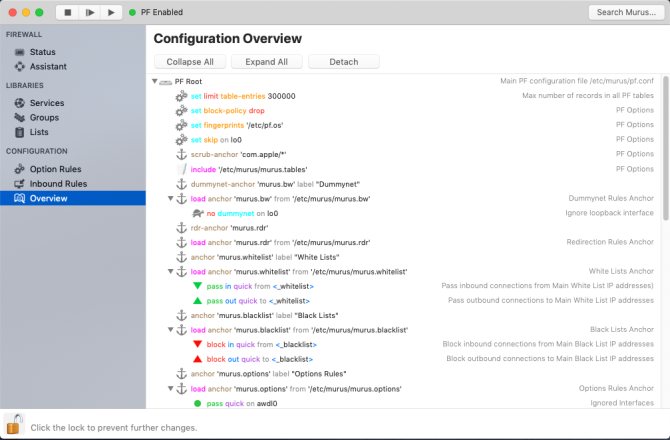

- #Mac os firewall settings how to
- #Mac os firewall settings mac os x
- #Mac os firewall settings software
The Leopard firewall patch comes less than 24 hours after Apple shipped a monster update to cover at least 41 Mac OS X and Safari for Windows (beta) vulnerabilities. A user might expect changes to take effect immediately and so leave their system exposed to network access. This could result in the unexpected exposure of network services.ĬVE-2007-4704: When the Application Firewall settings are changed, a running process started by launchd will not be affected until it is restarted. Two other Application Firewall flaws are addressed:ĬVE-2007-4703: The "Set access for specific services and applications" setting for the Application Firewall allows any process running as user "root" (UID 0) to receive incoming connections, even if its executable is specifically added to the list of programs and its entry in the list is marked as "Block incoming connections". We’ll navigate there, then look through the available firewall settings. The firewall is found in System Preferences.

#Mac os firewall settings how to
Also read: How to Fully Secure Your Mac with These 9 Steps.
#Mac os firewall settings software
With the fix, the firewall will more accurately describe the option as "Allow only essential services", and by limiting the processes permitted to receive incoming connections under this setting to a small fixed set of system services, Apple said You can also replace your Mac’s software firewall with a third-party firewall, seen at the bottom of the post. This could result in the unexpected exposure of network services," Apple said. "The 'Block all incoming connections' setting for the Application Firewall allows any process running as user "root" (UID 0) to receive incoming connections, and also allows mDNSResponder to receive connections. In an advisory accompanying the Mac OS X v10.5.1 update, Apple admitted that the "Block all incoming connections" setting for the firewall is misleading. The acknowledgment from Cupertino comes less than a month after independent researchers threw cold water on Apple's claim that Leopard's firewall can block all incoming connections. This can be avoided by upgrading to a version of the app that is signed by its developer.41 impressive questions to ask in a job interviewĪpple has fessed up to at least three serious design weaknesses in the new application-based firewall that ships with Mac OS X Leopard. Instead, it the "Allow or Deny" dialog appears every time the app is opened.

If the firewall recognizes such an app it doesn't sign it. Some apps check their own integrity when they are opened without using code signing.

If you want to deny a digitally signed application, you should first add it to the list and then explicitly deny it. If you choose Deny, OS X adds it to the list but denies incoming connections intended for this app. If you choose Allow, OS X signs the application and automatically adds it to the firewall list. If you run an unsigned app that is not listed in the firewall list, a dialog appears with options to Allow or Deny connections for the app. Apps included in OS X are signed by Apple and are allowed to receive incoming connections when this setting is enabled. For example, since iTunes is already signed by Apple, it is automatically allowed to receive incoming connections through the firewall. Applications that are signed by a valid certificate authority are automatically added to the list of allowed apps, rather than prompting the user to authorize them.


 0 kommentar(er)
0 kommentar(er)
